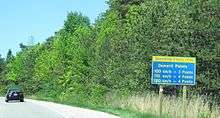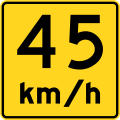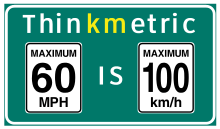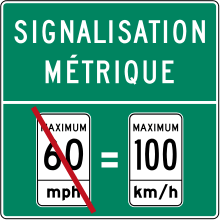Speed limits in Canada
Canadian speed limits are set by different levels of government (federal, provincial, and municipal), depending on the jurisdiction under which the road falls, resulting in differences from province to province.[1] The limits have been posted in kilometres per hour (km/h) since September 1, 1977. Before then, when Canada used Imperial units, speed limits were in miles per hour (mph).
Statutory speed limits
Statutory speed limits are default speed limits set by statute in each province or territory. They apply on roads which do not have posted speed limits.
Posted speed limits may differ significantly from the statutory speed limit. For example, in Alberta, Highway 1A has a statutory maximum speed limit of 100 km/h but a posted speed limit of 30 km/h near 51.169832°N 115.658684°W.
In most provinces and territories, statutory speed limits are 50 km/h (31 mph) in urban areas, 80 km/h (50 mph) in rural areas.[2][3] There is no statutory speed limit for grade-separated freeways; however the typical speed limit in most provinces is 100 km/h (62 mph) or 110 km/h (68 mph). Statutory speed limits for school zones tend to be 30 or 40 km/h (19 or 25 mph) in urban areas and 50 km/h in rural areas.[4]
The highest speed limit in Canada is found on British Columbia's Coquihalla Highway with a speed limit of 120 km/h (75 mph). Formerly, British Columbia's Okanagan Connector and Highway 19 also possessed 120 km/h limits, but have since been reduced to 110 km/h.
"N/A" means there is no such roadway in the province or territory. This table contains the statutory maximum speed limits, in kilometers per hour, on roads in each category.
| Province/Territory | Freeway (rural) | Freeway (urban) | Divided Highway (rural) | Undivided (rural) | Urban |
|---|---|---|---|---|---|
| 100 km/h (62 mph) for provincial highways (numbered highways) outside urban areas 80 km/h (50 mph) for unnumbered highways outside urban areas and numbered highways inside urban areas[5] | 50 km/h (31 mph) | ||||
| N/A | |||||
| N/A | |||||
| N/A | |||||
This table contains typical daytime speed limits, in kilometers per hour, on typical roads in each category. The values shown are not necessarily the fastest or slowest posted limit.
| Province/Territory | Freeway (rural) | Freeway (urban) | Divided Highway (rural) | Undivided (rural) | Urban |
|---|---|---|---|---|---|
| 90–110 km/h (56–68 mph) | 50–100 km/h (31–62 mph) | 80–110 km/h (50–68 mph) | 60–100 km/h (37–62 mph) | 50 km/h (31 mph) | |
| 110–120 km/h (68–75 mph) | 90–110 km/h (56–68 mph) | 100–110 km/h (62–68 mph) | 80–110 km/h (50–68 mph) | 50 km/h (31 mph) | |
| N/A | 100 km/h (62 mph) | 100–110 km/h (62–68 mph) | 100 km/h (62 mph) | 50 km/h (31 mph) | |
| 110 km/h (68 mph) | 100–110 km/h (62–68 mph) | 110 km/h (68 mph) | 80–100 km/h (50–62 mph) | 50 km/h (31 mph) | |
| 100 km/h (62 mph) | 80–100 km/h (50–62 mph) | 100 km/h (62 mph) | 80–100 km/h (50–62 mph) | 50 km/h (31 mph) | |
| N/A | 100 km/h (62 mph) | 45 km/h (28 mph) | |||
| 100–110 km/h (62–68 mph) | 100 km/h (62 mph) | 100–110 km/h (62–68 mph) | 80–100 km/h (50–62 mph) | 50 km/h (31 mph) | |
| N/A | 90 km/h (56 mph) | 50 km/h (31 mph) | |||
| 100–110 km/h (62–68 mph) | 90–100 km/h (56–62 mph) | 90–100 km/h (56–62 mph) | 90 km/h (56 mph) | 50 km/h (31 mph) | |
| N/A | 80–90 km/h (50–56 mph) | 50 km/h (31 mph) | |||
| 110 km/h (68 mph) | 90–100 km/h (56–62 mph) | 100–110 km/h (62–68 mph) | 100 km/h (62 mph) | 50 km/h (31 mph) | |
| 100 km/h (62 mph) | 70–100 km/h (43–62 mph) | 100 km/h (62 mph) | 80–90 km/h (50–56 mph) | 50 km/h (31 mph) | |
| N/A | 70 km/h (43 mph) | 100 km/h (62 mph) | 50 km/h (31 mph) | ||
Regulations

Community safety zones
In Ontario, speeding fines double in areas identified as "Community Safety Zones".
Construction zones
In most Canadian provinces, as in most other locales, speed violation fines are double (or more) in construction zones, although in Ontario and Alberta, this only applies if workers are present in the construction zone.
Racing, contests and stunt driving
In Ontario, as of September 2007, drivers caught exceeding the posted speed limit by 50 km/h or more may have the vehicle that they are driving impounded immediately for seven days, have their license suspended for seven days, and have to appear before the court. For a first conviction, they face an additional $2,000-$10,000 fine and six demerit points; they may also face up to six months in jail and license suspension of up to two years. For a second conviction within 10 years of the first conviction, their license may be suspended for up to 10 years.[6]
Truck speed limiters
Since 2009 in both Ontario[7] and Québec,[8] trucks must be equipped with devices to electronically limit their speed to 105 km/h (65 mph). In 2012, an Ontario court ruled that the law violated the Canadian Charter of Rights and Freedoms, however the law was upheld by the Ontario Court of Appeal in 2015.[9]
Radar detectors
Radar detectors in Canada are legal only in British Columbia, Alberta and Saskatchewan. They are illegal to use or possess in the other provinces and all three territories. Regardless of whether they are used or not, police and law enforcement officers may confiscate radar detectors, operational or not, and impose substantial fines in provinces where radar detectors are illegal.[10] Quebec penalizes $500 for use of a radar detector, along with confiscation of the device.[11]
Signage
A speed limit sign reads "MAXIMUM XX", such as "MAXIMUM 80" for 80 km/h. A minimum speed sign reads "XX MINIMUM", such as "60 MINIMUM" for 60 km/h.
 Speed limit sign
Speed limit sign Minimum speed limit sign
Minimum speed limit sign Speed limit sign in Ontario
Speed limit sign in Ontario Speed limit sign in British Columbia and Yukon
Speed limit sign in British Columbia and Yukon Upcoming/advance notice of speed limit change sign
Upcoming/advance notice of speed limit change sign Upcoming/advance notice of speed limit change sign in British Columbia and Yukon
Upcoming/advance notice of speed limit change sign in British Columbia and Yukon Speed limit change sign in Ontario
Speed limit change sign in Ontario Speed limit sign in Quebec
Speed limit sign in Quebec Speed limit ends sign in British Columbia
Speed limit ends sign in British Columbia Recommended speed sign
Recommended speed sign Exit recommended speed sign in Quebec; Anglophone signs read EXIT or RAMP
Exit recommended speed sign in Quebec; Anglophone signs read EXIT or RAMP Exit recommended speed sign in Ontario
Exit recommended speed sign in Ontario Metric signage reminder in British Columbia, posted on highways near the US border, to and from ferry terminals on Vancouver Island, and international airports
Metric signage reminder in British Columbia, posted on highways near the US border, to and from ferry terminals on Vancouver Island, and international airports Metric signage reminder in Quebec, posted near US border
Metric signage reminder in Quebec, posted near US border
Review of speed limits
British Columbia
In British Columbia, a review of speed limits conducted in 2002 and 2003 for the Ministry of Transportation found that posted limits on investigated roads were unrealistically low for 1,309 km and unrealistically high for 208 km. The report recommended increasing speed limits on multi-lane limited-access highways constructed to high design standards from 110 km/h to 120 km/h.[12] As described in that report, the Ministry is currently using "...Technical Circular T-10/00 [...] to assess speed limits. The practice considers the 85th percentile speed, road geometry, roadside development, and crash history." In July 2014, speed limits were adjusted on many of the province's highways, including some which were increased to 120 km/h (75 mph), currently the highest speed limit in Canada.[13]
Ontario
Ontario's first provincial legislation governing automobile use came into effect in 1903, which included a 15 mph (24 km/h) speed limit. The first provincial Highway Traffic Act (passed in 1923)[14] changed the speed limit for highways to 25 mph (40 km/h).[15]
Limits were later increased, for rural roads, to 50 mph (80 km/h) and then again to 60 mph (97 km/h). In 1968, the maximum speed limit for freeways was raised to 70 mph (110 km/h). In 1976, the maximum speed limit for freeways was reduced to 60 mph, while the rural limit was reduced to 50 mph, except for main highways running through northern Ontario, which were reduced to 55 mph.
In 1977, highways started using the metric system, with speeds being increased slightly to a maximum ranging from 80 to 100 km/h (50 to 62 mph).
In 2013, "speed too fast / exceed speed limit" contributed to 18.4% of all collisions,[16] while "speeding" accounted for 55.2% of all driving convictions.[17] An Ontario-based group is lobbying to increase speed limits from 100 km/h to 120-130 km/h (80 mph).[18]
In 2015, the Ontario government announced a plan to reduce residential speed limits from the statutory default 50 km/h, either by reducing the statutory limit to 40 km/h or by giving municipalities the option to set their own statutory speed limits, as well as allowing posted speed limits in school zones to be lowered to 30 km/h.[19]
On September 26, 2019, speed limits were increased, in a two-year trial, to 110 km/h (68 mph) from 100 km/h (62 mph) as part of a pilot across Highway 402 from London to Sarnia (90 km), the Queen Elizabeth Way from St. Catharines/Lincoln to Hamilton (32 km), and Highway 417 from Ottawa/Gloucester to the Ontario/Quebec border (102 km).[20][21]
References
- Gilchrist, C.W. "Roads and Highways". www.thecanadianencyclopedia.ca. The Canadian Encyclopedia. Archived from the original on 14 December 2017. Retrieved 31 October 2017.
- "Driving to Prince Edward Island". 21 January 2015. Archived from the original on 28 September 2013.
- "Archived copy" (PDF). Archived (PDF) from the original on 2013-09-28. Retrieved 2013-09-26.CS1 maint: archived copy as title (link)
- "Safer School Zone Q&A - novascotia.ca". novascotia.ca. Archived from the original on 2017-11-06.
- Traffic Safety Act, RSA 2000, c T-6
- "Law Document English View". 24 July 2014. Archived from the original on 23 August 2017.
- Brennan, Richard J. (7 June 2012). "Ontario court declares speed limiters for trucks unconstitutional". Toronto Star. Retrieved 29 July 2019.
- "Quebec truckers admit to tampering with speed limiters". CBC News. 24 April 2012. Retrieved 29 July 2019.
- Craggs, Samantha (3 September 2015). "Court rejects truckers' bid to go faster on Ontario highways". CBC News. Retrieved 29 July 2019.
- "United States Department of State: Consular Information Sheet for Canada". Travel.state.gov. Archived from the original on 2008-09-13. Retrieved 2010-10-17.
- "Archived copy". Archived from the original on 2010-08-23. Retrieved 2011-07-15.CS1 maint: archived copy as title (link)
- "MoT Speed Review Report" (PDF). Archived (PDF) from the original on 2009-12-29.
- "Speed limits on some B.C. highways to hit 120 km/h". CBC News. 2 July 2014. Archived from the original on 19 November 2015. Retrieved 9 December 2015.
- "Changes To The Highway Traffic Act Coming In Ontario". LifeSafer of Canada. 2015-03-06. Retrieved 2020-04-27.
Although the act itself has been around since 1923...
- Government of Ontario, Ministry of Transportation. "History of Ministry of Transportation". www.mto.gov.on.ca.
- "Table 2.8: Apparent Driver Action by Class of Collision, 2013" (PDF). Ontario Ministry of Transportation. 2014. Archived (PDF) from the original on 2017-05-16.
- "Table 7.2: Motor Vehicle Convictions Related to the Highway Traffic Act, 2013" (PDF). Ontario Ministry of Transportation. 2014. Archived (PDF) from the original on 2017-05-16.
- "Ontario org. wants highway speed limits increased from 100 km/h". 18 April 2012. Archived from the original on 22 April 2012.
- "Lower residential speed limit considered by Ontario government". CBC News Ottawa. 29 January 2015. Archived from the original on 4 December 2015. Retrieved 9 December 2015.
- "Ontario Introduces Speed Limit Pilots and Consultations". news.ontario.ca.
- "Highway speed limits jump to 110 km/h in pilot project". cbc.ca. September 24, 2019.